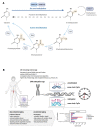Oocyte Aging: A Multifactorial Phenomenon in A Unique Cell
- PMID: 37307833
- PMCID: PMC10796106
- DOI: 10.14336/AD.2023.0527
Oocyte Aging: A Multifactorial Phenomenon in A Unique Cell
Abstract
The oocyte is considered to be the largest cell in mammalian species. Women hoping to become pregnant face a ticking biological clock. This is becoming increasingly challenging as an increase in life expectancy is accompanied by the tendency to conceive at older ages. With advancing maternal age, the fertilized egg will exhibit lower quality and developmental competence, which contributes to increased chances of miscarriage due to several causes such as aneuploidy, oxidative stress, epigenetics, or metabolic disorders. In particular, heterochromatin in oocytes and with it, the DNA methylation landscape undergoes changes. Further, obesity is a well-known and ever-increasing global problem as it is associated with several metabolic disorders. More importantly, both obesity and aging negatively affect female reproduction. However, among women, there is immense variability in age-related decline of oocytes' quantity, developmental competence, or quality. Herein, the relevance of obesity and DNA-methylation will be discussed as these aspects have a tremendous effect on female fertility, and it is a topic of continuous and widespread interest that has yet to be fully addressed for the mammalian oocyte.
Conflict of interest statement
The Authors declare no Competing Financial or Non-Financial Interests.
Figures




Similar articles
-
Mechanisms of oocyte aneuploidy associated with advanced maternal age.Mutat Res Rev Mutat Res. 2020 Jul-Sep;785:108320. doi: 10.1016/j.mrrev.2020.108320. Epub 2020 Jul 4. Mutat Res Rev Mutat Res. 2020. PMID: 32800274 Review.
-
Resveratrol and SIRT1: Antiaging Cornerstones for Oocytes?Nutrients. 2022 Dec 1;14(23):5101. doi: 10.3390/nu14235101. Nutrients. 2022. PMID: 36501130 Free PMC article. Review.
-
Age-related decline in fertility: a link to degenerative oocytes?Fertil Steril. 1997 Aug;68(2):265-71. doi: 10.1016/s0015-0282(97)81513-0. Fertil Steril. 1997. PMID: 9240254
-
Mitochondria-targeted therapy rescues development and quality of embryos derived from oocytes matured under oxidative stress conditions: a bovine in vitro model.Hum Reprod. 2019 Oct 2;34(10):1984-1998. doi: 10.1093/humrep/dez161. Hum Reprod. 2019. PMID: 31625574
-
Effects of maternal age on oocyte developmental competence.Theriogenology. 2001 Apr 1;55(6):1303-22. doi: 10.1016/s0093-691x(01)00484-8. Theriogenology. 2001. PMID: 11327686 Review.
Cited by
-
Ovarian aging: energy metabolism of oocytes.J Ovarian Res. 2024 May 31;17(1):118. doi: 10.1186/s13048-024-01427-y. J Ovarian Res. 2024. PMID: 38822408 Free PMC article. Review.
-
Elucidating the Role of Sirtuin 3 in Mammalian Oocyte Aging.Cells. 2024 Sep 22;13(18):1592. doi: 10.3390/cells13181592. Cells. 2024. PMID: 39329773 Free PMC article. Review.
-
What is driving the global decline of human fertility? Need for a multidisciplinary approach to the underlying mechanisms.Front Reprod Health. 2024 Apr 25;6:1364352. doi: 10.3389/frph.2024.1364352. eCollection 2024. Front Reprod Health. 2024. PMID: 38726051 Free PMC article. Review.
-
Population decline: where demography, social science, and biology intersect.Reproduction. 2024 May 31;168(1):e240070. doi: 10.1530/REP-24-0070. Print 2024 Jul 1. Reproduction. 2024. PMID: 38579804 Free PMC article. Review.
-
Sirtuin 5-driven meiotic spindle assembly and actin-based migration in mouse oocyte meiosis.Heliyon. 2024 Jun 5;10(11):e32466. doi: 10.1016/j.heliyon.2024.e32466. eCollection 2024 Jun 15. Heliyon. 2024. PMID: 38933958 Free PMC article.
References
-
- Mastenbroek S, de Wert G, Adashi EY (2021). The Imperative of Responsible Innovation in Reproductive Medicine. N Engl J Med, 385(22):2096-2100. - PubMed
-
- Kemkes-Grottenthaler A (2003). Postponing or rejecting parenthood? Results of a survey among female academic professionals. J Biosoc Sci, 35:213-226. - PubMed
Publication types
MeSH terms
Grants and funding
LinkOut - more resources
Full Text Sources
Medical
